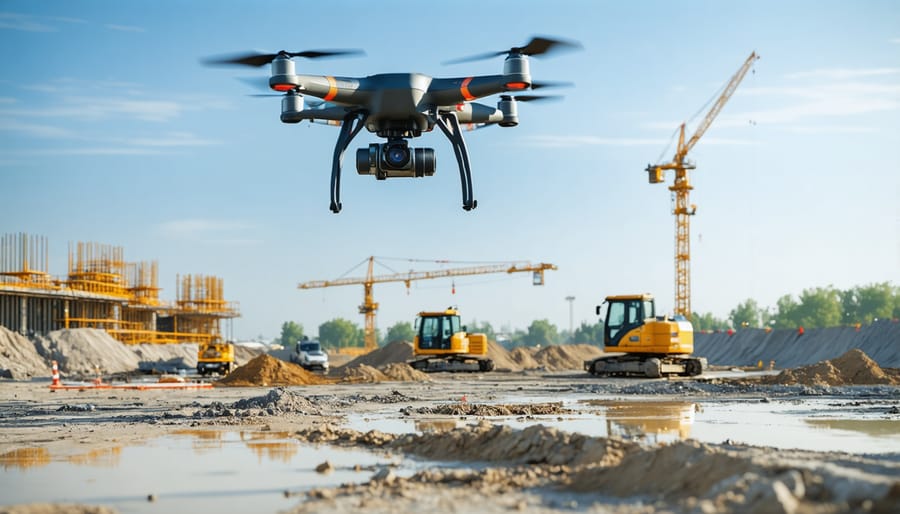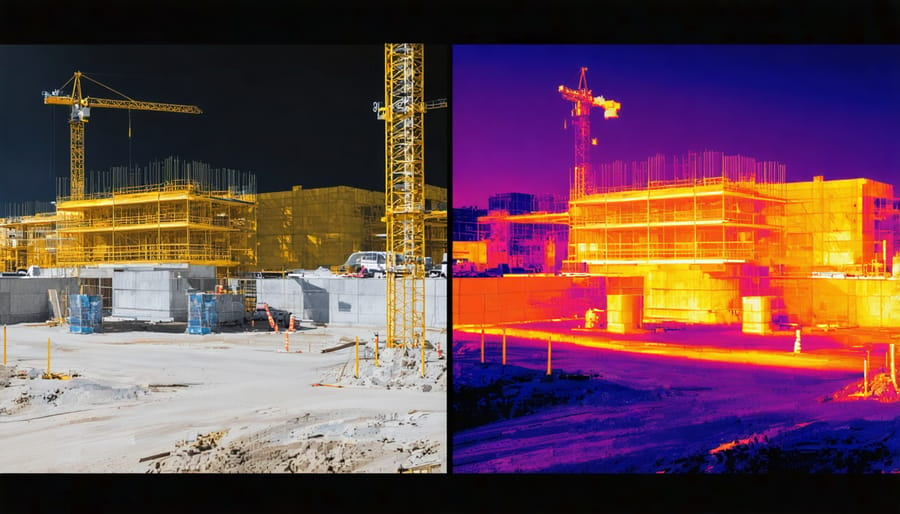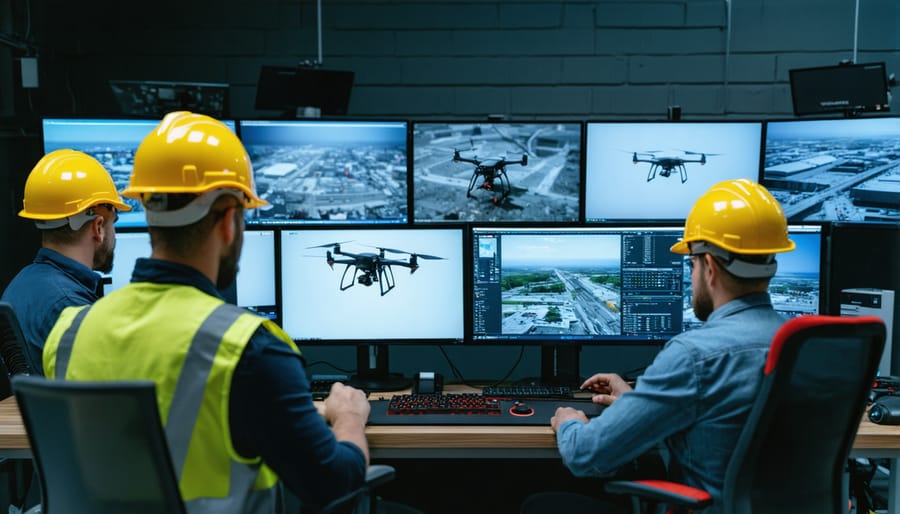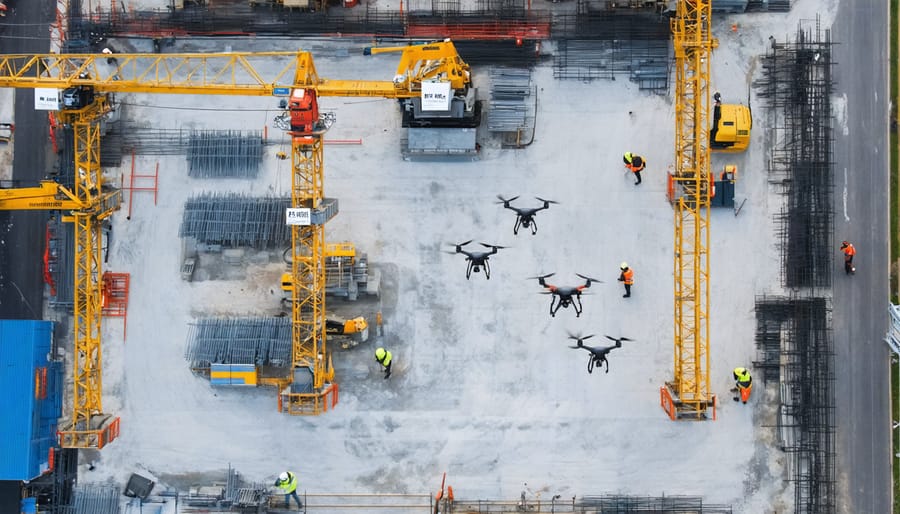Unmanned Aerial Vehicles (UAVs) have emerged as one of the most transformative safety technologies revolutionizing construction site monitoring and management. Recent industry data reveals that construction firms implementing UAV systems report a 65% improvement in project safety metrics and a 52% reduction in inspection time. These sophisticated aerial platforms, equipped with high-resolution cameras, LiDAR sensors, and thermal imaging capabilities, are fundamentally changing how construction professionals approach site surveillance, progress tracking, and risk assessment.
The integration of UAVs into construction operations represents a critical advancement in both efficiency and safety protocols, offering unprecedented aerial perspectives of construction sites while keeping personnel safely on the ground. From automated flight paths for consistent data collection to real-time transmission of visual analytics, modern UAV systems provide construction managers with powerful tools for making informed decisions about site safety and project progress.
As regulatory frameworks evolve and technology continues to advance, understanding the proper implementation of UAV systems has become essential for construction professionals seeking to maintain competitive advantage while ensuring optimal site safety conditions.
Essential UAV Components for Construction Safety Applications

High-Resolution Imaging Systems
High-resolution imaging systems are crucial components of UAV safety monitoring platforms in construction environments. Modern drone cameras should feature at least 20MP resolution and 4K video capabilities to capture detailed structural elements and potential hazards. The industry standard typically requires a 1-inch CMOS sensor or larger, ensuring excellent performance in various lighting conditions.
For effective safety monitoring, drones should be equipped with cameras offering adjustable parameters such as ISO sensitivity (100-12800 range), mechanical shutters to prevent rolling shutter distortion, and variable aperture settings (f/2.8-f/11). These specifications enable clear capture of both static and moving elements on construction sites.
Thermal imaging capabilities are increasingly becoming essential for comprehensive safety inspections. Integration of radiometric thermal cameras with resolutions of 640 × 512 pixels or higher allows for detection of heat anomalies, potential electrical issues, and structural concerns not visible to the naked eye.
Storage systems should accommodate high-bitrate recording, with support for multiple memory cards (64GB minimum) to ensure uninterrupted documentation during extended flight missions. Real-time transmission systems should maintain at least 720p resolution with minimal latency for immediate hazard identification.
Thermal and Infrared Capabilities
Thermal imaging capabilities in modern UAVs have revolutionized construction site monitoring by enabling real-time detection of thermal anomalies and potential safety hazards. Advanced infrared sensors can identify temperature variations that may indicate electrical hotspots, insulation failures, or structural weaknesses before they become critical issues.
These systems typically operate in temperature ranges from -20°C to 500°C, providing high-resolution thermal mapping with accuracy within ±2°C. The integration of radiometric thermal cameras allows for precise temperature measurement at specific points, essential for monitoring concrete curing processes and identifying areas of heat loss in building envelopes.
Construction teams can leverage thermal drone surveys to detect moisture intrusion, assess HVAC efficiency, and verify proper installation of thermal insulation. The data collected through thermal imaging can be processed into detailed heat maps and 3D thermal models, enabling project managers to make informed decisions about remedial actions and preventive maintenance.
Autonomous Navigation Features
Modern UAV systems employ sophisticated navigation technologies to ensure precise and reliable site monitoring operations. GPS-RTK (Real-Time Kinematic) systems provide centimeter-level positioning accuracy, while integrated inertial measurement units (IMUs) maintain stable flight paths even in challenging conditions. Advanced obstacle avoidance sensors, including LiDAR and stereoscopic cameras, enable drones to navigate safely around structures and equipment.
Autonomous flight planning software allows operators to pre-program inspection routes with multiple waypoints, ensuring consistent coverage of construction sites. These systems can maintain precise altitudes and distances from structures while automatically adjusting for wind conditions and environmental factors. Machine learning algorithms enhance navigation capabilities by recognizing and adapting to site-specific features and potential hazards.
For reliable operation in GPS-denied environments, such as indoor spaces or areas with strong signal interference, modern UAVs utilize visual positioning systems (VPS) and simultaneous localization and mapping (SLAM) technology. These redundant navigation systems ensure uninterrupted monitoring capabilities across diverse construction environments.
Regulatory Compliance and Safety Standards

FAA Requirements
Construction drone operations must strictly comply with Federal Aviation Administration (FAA) regulations under Part 107 of the Federal Aviation Regulations. Operators must obtain a Remote Pilot Certificate by passing the FAA’s aeronautical knowledge test and registering their drones with the FAA if they weigh more than 0.55 pounds.
Key operational requirements include maintaining visual line of sight with the drone, flying below 400 feet above ground level, and operating only during daylight hours. For construction sites in controlled airspace, operators must obtain authorization through the LAANC system before conducting flights.
Construction companies must ensure their drone operations maintain a minimum distance from people not directly involved in the operation and avoid flying over moving vehicles. Special waivers may be required for operations beyond these standard limitations, such as flying at night or over people.
Documentation is crucial – operators must maintain flight logs, conduct pre-flight inspections, and report any incidents involving injury or property damage exceeding $500. Construction firms should also implement internal policies that align with FAA requirements while addressing site-specific safety considerations.
Staying current with FAA regulations is essential, as requirements may change based on new legislation or safety considerations.
Construction Industry Standards
Construction industry standards for UAV operations emphasize safety, compliance, and operational efficiency. The American Society of Safety Professionals (ASSP) has established guidelines requiring UAV operators to maintain a minimum safe distance of 50 feet from workers and structures during monitoring operations. These standards align with OSHA requirements for workplace safety while incorporating drone-specific considerations.
Key compliance requirements include maintaining visual line of sight, implementing collision avoidance protocols, and establishing emergency procedures. Construction firms must ensure their UAV operations adhere to ANSI A10.42 standards for equipment inspection and monitoring, particularly when conducting aerial surveys of high-risk areas such as tower cranes and scaffolding.
Documentation requirements mandate detailed flight logs, maintenance records, and operator certifications. Project managers must integrate UAV safety protocols into their site-specific safety plans, including designated takeoff and landing zones, communication procedures, and weather-related operational limitations.
Regular calibration and equipment checks are essential, with standards specifying pre-flight inspections and post-flight maintenance protocols. Construction firms must also maintain comprehensive insurance coverage specifically addressing UAV operations, with liability limits typically starting at $1 million per occurrence.
Industry best practices recommend implementing a dedicated UAV safety management system that integrates with existing construction safety protocols while addressing unique aerial operation risks.
Real-Time Monitoring Capabilities
Data Collection Systems
Modern UAVs in construction incorporate sophisticated sensor arrays that revolutionize data collection and site monitoring capabilities. High-resolution cameras, equipped with both RGB and thermal imaging sensors, enable comprehensive visual documentation and heat mapping for structural analysis. LiDAR (Light Detection and Ranging) sensors provide precise 3D mapping and volumetric measurements, essential for earthwork calculations and progress monitoring.
Multispectral sensors enhance material analysis capabilities, detecting potential structural issues before they become visible to the naked eye. Integration of GPS and IMU (Inertial Measurement Unit) systems ensures accurate geolocation data and stable flight paths, crucial for repeatable survey routes and precise measurements.
Real-time data transmission systems allow immediate access to collected information, facilitating quick decision-making on site. This data must be protected through robust data security protocols to safeguard sensitive project information.
Advanced UAVs also feature environmental sensors monitoring air quality, temperature, and humidity levels, contributing to comprehensive site safety assessments. The integration of artificial intelligence and machine learning algorithms enables automated analysis of collected data, identifying patterns and potential safety concerns that might otherwise go unnoticed.
These systems can be customized based on project requirements, with modular sensor configurations allowing for specialized applications such as concrete curing monitoring or structural integrity assessment.
Communication Infrastructure
Effective communication infrastructure is crucial for successful UAV operations in construction environments. Modern drone systems rely on robust data transmission networks that enable real-time monitoring and instant decision-making capabilities. The primary components include telemetry systems, ground control stations (GCS), and secure data links that operate on multiple frequency bands.
Most professional construction UAVs utilize dual-frequency communication systems operating on both 2.4GHz and 5.8GHz bands, providing redundancy and reliable connectivity even in challenging site conditions. The integration of 4G/5G cellular networks has further enhanced data transmission capabilities, allowing for extended range operations and seamless connectivity across large construction sites.
Real-time video feeds typically operate at 720p to 4K resolution, transmitted through dedicated channels that ensure minimal latency. These feeds, combined with AI-powered safety analytics, enable immediate hazard detection and response. Modern systems also incorporate redundant communication protocols and fail-safe mechanisms to maintain operational safety during signal interruptions.
Data encryption and secure transmission protocols protect sensitive project information, while cloud-based storage solutions enable immediate access to collected data across multiple devices and locations. The implementation of mesh network capabilities allows multiple UAVs to operate simultaneously while maintaining stable communications with the ground control station, enhancing overall site monitoring efficiency.

Implementation Best Practices
Flight Planning and Risk Assessment
Effective flight planning and risk management planning are crucial components of successful UAV operations in construction environments. Before each flight mission, operators must conduct thorough site assessments to identify potential hazards such as overhead power lines, tall structures, and areas with high pedestrian traffic. A comprehensive pre-flight checklist should include weather conditions assessment, battery status verification, and communication protocols establishment.
Risk mitigation strategies should address both technical and operational aspects. This includes maintaining safe distances from personnel and equipment, establishing emergency landing zones, and implementing fail-safe procedures for equipment malfunction scenarios. Operators must also consider environmental factors such as wind speed, visibility conditions, and electromagnetic interference that could affect UAV performance.
Documentation of flight plans, including detailed mission objectives, flight paths, and contingency procedures, is essential for maintaining safety standards and ensuring compliance with regulatory requirements. Regular updates to these plans based on changing site conditions and lessons learned from previous flights help optimize safety protocols and operational efficiency.
Staff Training Requirements
Proper training is essential for personnel involved in UAV construction site operations. Operators must complete comprehensive certification programs that comply with federal aviation regulations, including obtaining a Remote Pilot Certificate from the FAA under Part 107. This certification covers airspace regulations, weather conditions, emergency procedures, and operational limitations.
Beyond basic pilot certification, staff should receive specialized training in construction-specific applications, including aerial photography, photogrammetry, and 3D mapping techniques. Training programs should also cover site-specific safety protocols, communication procedures, and emergency response plans.
Equipment maintenance personnel require technical training on UAV systems, including routine inspections, component replacement, and troubleshooting procedures. Data analysts need training in specialized software for processing aerial imagery and creating actionable reports.
Regular refresher courses and safety briefings are mandatory to maintain operational excellence and stay current with evolving regulations and technology. Companies should maintain detailed training records and implement a competency assessment program to ensure all operators maintain the necessary skills for safe and effective UAV operations.
Emergency Response Integration
Integrating UAVs into emergency response protocols enhances safety and efficiency during critical situations on construction sites. The integration process requires establishing clear communication channels between UAV operators, emergency responders, and site management teams. Standard Operating Procedures (SOPs) should outline specific roles, responsibilities, and protocols for various emergency scenarios.
Key integration components include real-time video transmission to emergency command centers, automated alert systems triggered by drone-detected anomalies, and predetermined flight paths for emergency situations. UAVs equipped with thermal imaging and high-resolution cameras can provide vital information about fire spread, structural instability, or personnel locations during emergencies.
Emergency response teams should conduct regular drills incorporating UAV systems to ensure seamless coordination. These exercises help identify potential communication gaps and optimize response times. Documentation should include emergency landing zones, no-fly areas during specific types of emergencies, and backup procedures in case of drone system failures.
Site managers must also ensure that emergency protocols comply with local aviation regulations and first responder guidelines while maintaining effective communication with surrounding facilities and authorities during crisis situations.
The integration of UAV technology in construction safety monitoring has proven to be a game-changing advancement for the industry. By providing real-time aerial surveillance, data collection, and risk assessment capabilities, drones have significantly enhanced workplace safety while reducing operational costs and improving efficiency.
The demonstrated benefits include reduced workplace accidents, improved compliance monitoring, faster emergency response times, and enhanced documentation of safety protocols. Construction companies implementing UAV systems have reported up to 65% reduction in safety incidents and a 40% increase in hazard identification efficiency.
Looking ahead, the future of UAV construction safety monitoring appears increasingly promising. Technological advancements in artificial intelligence and machine learning are enabling more sophisticated automated threat detection and predictive analytics. The integration of thermal imaging, LiDAR sensors, and advanced imaging systems will further expand monitoring capabilities.
Industry experts predict that by 2025, over 80% of large construction projects will incorporate UAV safety monitoring as a standard practice. Regulatory frameworks are evolving to accommodate these technological advances, with authorities developing more streamlined approval processes for construction-specific drone operations.
As costs continue to decrease and technology becomes more accessible, even smaller construction firms will be able to leverage UAV solutions for safety monitoring. This democratization of drone technology, combined with ongoing improvements in battery life, sensor capabilities, and automated systems, will revolutionize how the construction industry approaches workplace safety and risk management.

